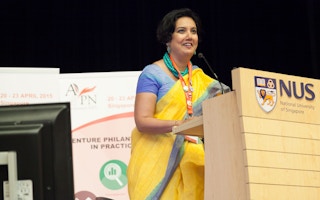Philanthropy in Asia has evolved beyond just giving away money to charities or short-term projects to meet immediate needs. Instead, corporations and foundations are increasingly deploying their funds to help organisations with social impact build capacities and become self-sustaining entities.
To continue reading, subscribe to Eco‑Business.
There's something for everyone. We offer a range of subscription plans.
- Access our stories and receive our Insights Weekly newsletter with the free EB Member plan.
- Unlock unlimited access to our content and archive with EB Circle.
- Publish your content with EB Premium.
Speaking at an event by the Asian Venture Philanthropy Network (AVPN) held in Singapore on April 20, Ming Tan, director of the Como Foundation, said that while foundations are still funding projects in countries with the greatest need, they are increasingly taking a longer-term view of the impact of their work.
Venture philanthropy uses concepts in venture capital finance and applies them to philanthropic projects and goals.
The models can range from grant-making by foundations or individuals, or partnering with grantees to achieve measurable outcomes, whether they be building a school in rural Cambodia or capacity building, for example, strengthening the skills, competencies and abilities of people in need or even in the grantee organisations.
At the conference, about 475 delegates from 28 countries discussed the latest developments, best practices and outstanding case studies in the region. The annual conference, in its third edition, focuses on “Venture Philanthropy in Practice” this year.
Tan said that over the past 12 years, in the course of her work with Como - the philanthropic arm of luxury retail and hospitality company Como Group - she has been approached by organisations that often seek funding to merely sustain projects for the next 12 to 18 months.
Often, the key managers of these organisers don’t even get paid.
That was simply unsustainable, she thought, and that made her think about possible solutions. One way is to build up the skills and competencies of fund-raisers and CEOs, or fund groups that need help in drafting their longer-term strategy and growth plan, she said.
“
Money shouldn’t just be money. It should come with connections, capabilities, skills transfer. We want to affect systematic change.
Jonathan Chang, executive director, Lien Centre for Social Innovation
“That way, they can raise their own salaries and build strong organisations, which should be the focus at the end of the day,” Tan said. “The stronger the organisations, the less need there is for us. Our job is to ‘grant’ ourselves out of relevance.”
This is also in line with the focus of Como Foundation, which is to support income-generation, education, and skill development programmes for at-risk women and girls in developing countries and empower them for sustainable livelihoods.
Jonathan Chang, executive director of the Lien Centre for Social Innovation, shares the view that philanthropy has to have purpose and impact beyond the immediate good.
“Money shouldn’t just be money,” he said. “It should come with connections, capabilities, skills transfer. We want to affect systematic change.”
The Lien Centre, a partnership between the Lien Foundation and Singapore Management University, does this by focusing on three areas – media engagement, applied research and capacity building.
The last area seeks to strengthen the philanthropy sector by providing education and tapping the expertise of public, private and non-profit sectors to drive social change, Chang said.
Como Foundation and the Lien Centre are both part of AVPN, which has 213 corporate members in 28 countries, mostly based in Asia. The group wants to continue growing and become the bridge between organisations in need and philanthropic funds in the region.
“We believe there’s a vast need for philanthropy in Asia but there’s no market for it. We’re here to connect the capital and create a platform for collaboration,” said Doug Miller, chairman of AVNP.
Between them, the members have contributed more than US$360 million to social enterprises across Asia since AVPN was established 3 years ago. With offices in Singapore, Japan, South Korea and India, AVPN wants to expand to the Philippines and Taiwan.
The biggest sectors that are represented in the association are organisations involved in venture philanthropy and impact investing.
The concept of impact investing has indeed grown, said Mario Knoepfel, director of values-based investing in Asia-Pacific for UBS.
Three years ago, when he moved to the city to head up the new business unit, almost nobody knew what he meant when he said “values-based” investing. It is investing in businesses which incorporate sound environmental, social and governance (ESG) principles into their operations and shunning those that “do evil”, as he put it.
Now, more private banking clients are willing to consider values-based investing, he said.
He focuses on North Asia, covering Taiwan, Hong Kong, Macau and China and said that part of his job is to educate the bank’s clients on looking beyond the mere returns.
“I must say that there is varying degrees of awareness and understanding of impact investing, but people we talk to are more willing to listen now,” Knoepfel said.








